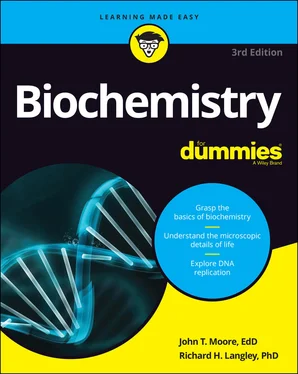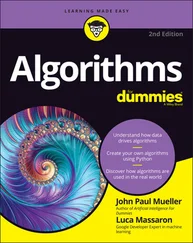 The Real World icon points out information that has a direct application in the everyday world. These paragraphs may also help you understand the bigger picture of how and why biochemical mechanisms are in place.
The Real World icon points out information that has a direct application in the everyday world. These paragraphs may also help you understand the bigger picture of how and why biochemical mechanisms are in place.
 This icon is a flag for those really important points that you shouldn’t forget while you go deeper into the world of biochemistry.
This icon is a flag for those really important points that you shouldn’t forget while you go deeper into the world of biochemistry.
 We use this icon to alert you to a tip on the easiest or quickest way to learn a concept. Between the two of us, we have almost 70 years of teaching experience. We’ve learned a few tricks along the way, and we don’t mind sharing.
We use this icon to alert you to a tip on the easiest or quickest way to learn a concept. Between the two of us, we have almost 70 years of teaching experience. We’ve learned a few tricks along the way, and we don’t mind sharing.
 The Warning icon points to a procedure or potential outcome that can be dangerous. We call it our Don’t-Try-This-At-Home icon.
The Warning icon points to a procedure or potential outcome that can be dangerous. We call it our Don’t-Try-This-At-Home icon.
As if this book wasn’t already chock full of helpful information, we provide you with a handy online Cheat Sheet that includes basic biochemical structures and genetic patterns. To access this Cheat Sheet, simply go to www.dummies.com and type Biochemistry For Dummies Cheat Sheetin the search box.
The answer to where you should start really depends on your prior knowledge and goals. Like with all For Dummies books, this one attempts to make all the chapters discrete so that you can pick a chapter that contains material you’re having difficulty with and get after it, without having to read other chapters first. If you feel comfortable with the topics covered in general and organic chemistry, feel free to skip Part I. If you want a general overview of biochemistry, skim the remainder of the book. Dive deeper into the gene pool when you find a topic that interests you.
And for all of you, no matter who you are or why you’re reading this book, we hope that you have fun reading it and that it helps you increase your understanding of biochemistry.
Part 1
Setting the Stage: Basic Biochemistry Concepts
IN THIS PART …
Getting to know biochemistry and its relationship to other disciplines within chemistry and biology
Diving into water chemistry, including pH and buffers
Brushing up on organic chemistry
Chapter 1
Biochemistry: What You Need to Know and Why
IN THIS CHAPTER
 Understanding the importance of biochemistry
Understanding the importance of biochemistry
 Looking at the parts and functions of animal cells
Looking at the parts and functions of animal cells
 Seeing the differences between animal and plant cells
Seeing the differences between animal and plant cells
If you’re enrolled in a biochemistry course, you may want to skip this chapter and go right to the specific chapter(s) in which we discuss the material you’re having trouble with. But if you’re thinking about taking a course in biochemistry or just want to explore an area that you know little about, keep reading. This chapter gives you basic information about cell types and cell parts, which are extremely important in biochemistry.
Sometimes you can get lost in the technical stuff and forget about the big picture. This chapter sets the stage for the details.
We suppose the flippant answer to the question “Why biochemistry?” is “Why not?” or “Because it’s required.”
That first response isn’t a bad answer, actually. Look around. See all the living or once living things around you? The processes that allow them to grow, multiply, age, and die are all biochemical in nature. Sometimes we sit back and marvel at the complexity of life, fascinated by the myriad chemical reactions that are taking place right now within our own bodies and the ways in which these biochemical reactions work together so we can sit and contemplate them.
When John learned about the minor structural difference between starch and cellulose, he remembers thinking, “Just that little difference in the one linkage between those units is basically the difference between a potato and a tree.” That fact made him want to learn more, to delve into the complexity of the chemistry of living things, to try to understand. We encourage you to step back from the details occasionally and marvel at the complexity and beauty of life.
What Is Biochemistry and Where Does It Take Place?
Biochemistry is the chemistry of living organisms. Biochemists study the chemical reactions that occur at the molecular level of organisms. Biochemistry is normally listed as a separate field of chemistry. However, in some schools it’s part of biology, and in others it’s separate from both chemistry and biology.
Biochemistry really combines aspects of all the fields of chemistry. Because carbon is the element of life, organic chemistry (the study of carbon-based compounds) plays a large part in biochemistry. Many times, biochemists study how fast reactions occur — that’s an example of physical chemistry. Often, metals are incorporated into biochemical structures (such as iron in hemoglobin) — that’s inorganic chemistry. Biochemists use sophisticated instrumentation to determine amounts and structures — that’s analytical chemistry. And biochemistry is also similar to molecular biology; both fields study living systems at the molecular level, but biochemists concentrate on the chemical reactions that occur.
Biochemists may study individual electron transport within the cell, or they may study the processes involved in digestion. If it’s alive, biochemists study it.
All living organisms contain cells. A cell is not unlike a prison cell. The working apparatus of the cell is imprisoned within the bars — known as the cell membrane. Just as a prison inmate can still communicate with the outside world, so can the cell’s contents. The prisoner must be fed, so nutrients must be able to enter every living cell. The cell has a sanitary system for the elimination of waste. And, just as inmates may work to provide materials for society outside the prison, a cell may produce materials for life outside the cell.
Cells come in two types: prokaryotes and eukaryotes. (Viruses also bear some similarities to cells, but these similarities are limited. In fact, many scientists don’t consider viruses to be living things.) Prokaryotic cells are the simplest type of cells. Many one-celled organisms are prokaryotes.
 The simplest way to distinguish between these two types of cells is that a prokaryotic cell contains no well-defined nucleus, whereas the opposite is true for a eukaryotic cell.
The simplest way to distinguish between these two types of cells is that a prokaryotic cell contains no well-defined nucleus, whereas the opposite is true for a eukaryotic cell.
Читать дальше

 The Real World icon points out information that has a direct application in the everyday world. These paragraphs may also help you understand the bigger picture of how and why biochemical mechanisms are in place.
The Real World icon points out information that has a direct application in the everyday world. These paragraphs may also help you understand the bigger picture of how and why biochemical mechanisms are in place. This icon is a flag for those really important points that you shouldn’t forget while you go deeper into the world of biochemistry.
This icon is a flag for those really important points that you shouldn’t forget while you go deeper into the world of biochemistry. We use this icon to alert you to a tip on the easiest or quickest way to learn a concept. Between the two of us, we have almost 70 years of teaching experience. We’ve learned a few tricks along the way, and we don’t mind sharing.
We use this icon to alert you to a tip on the easiest or quickest way to learn a concept. Between the two of us, we have almost 70 years of teaching experience. We’ve learned a few tricks along the way, and we don’t mind sharing. The Warning icon points to a procedure or potential outcome that can be dangerous. We call it our Don’t-Try-This-At-Home icon.
The Warning icon points to a procedure or potential outcome that can be dangerous. We call it our Don’t-Try-This-At-Home icon. Understanding the importance of biochemistry
Understanding the importance of biochemistry










